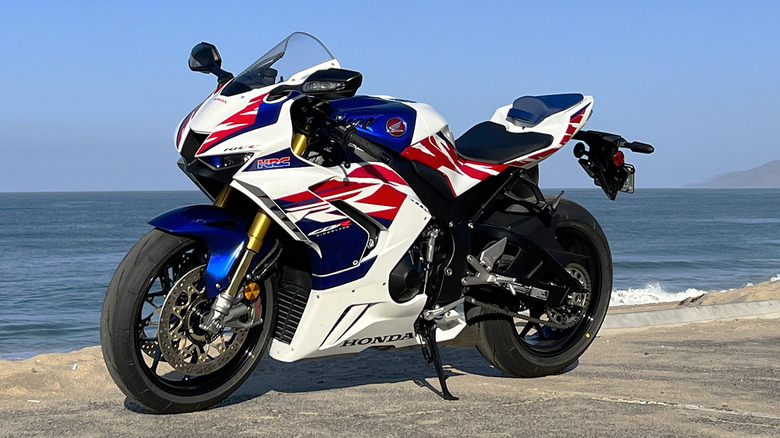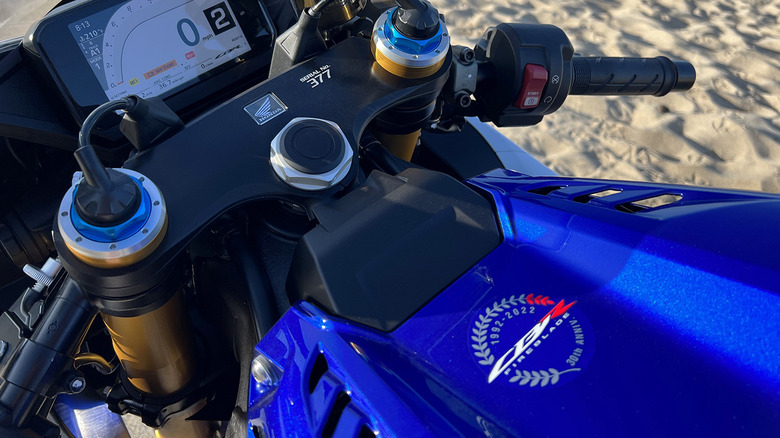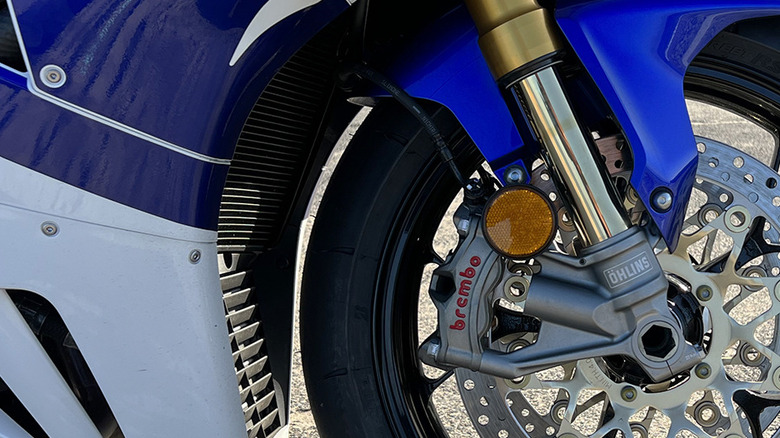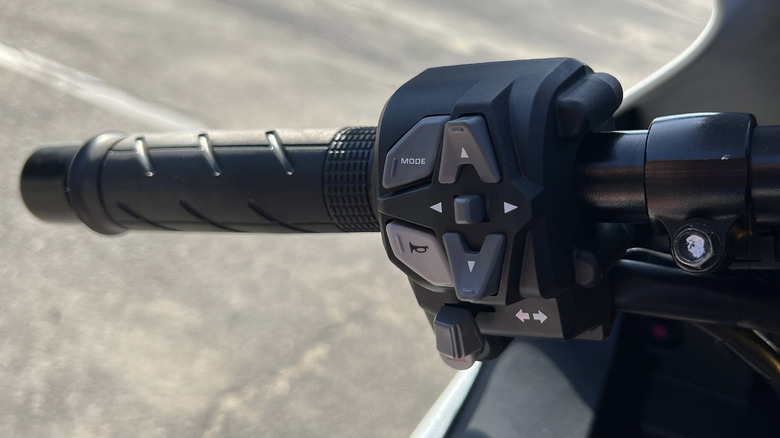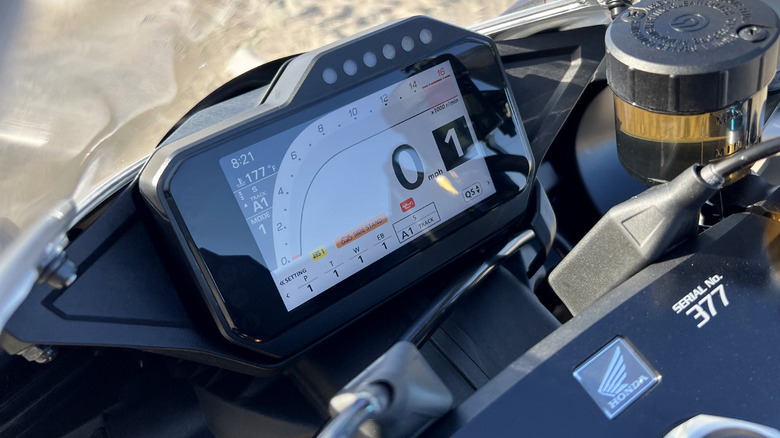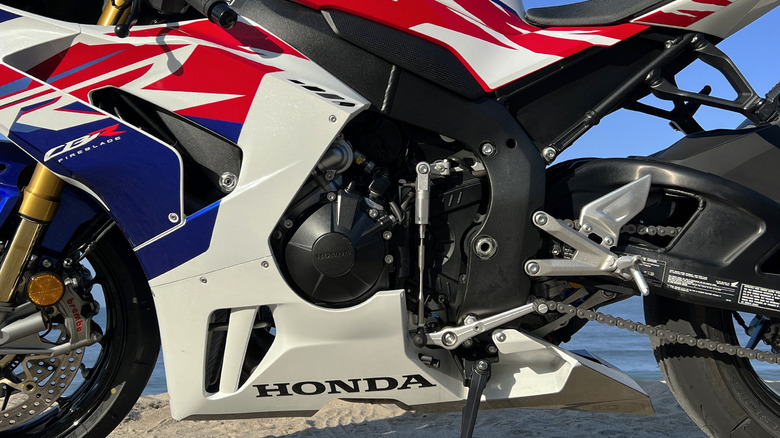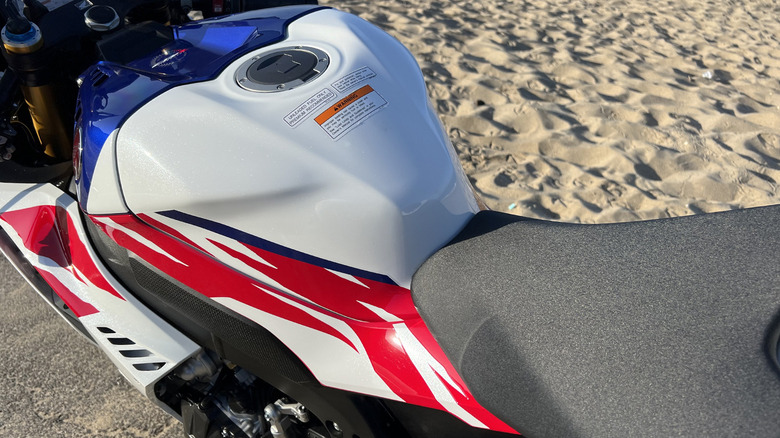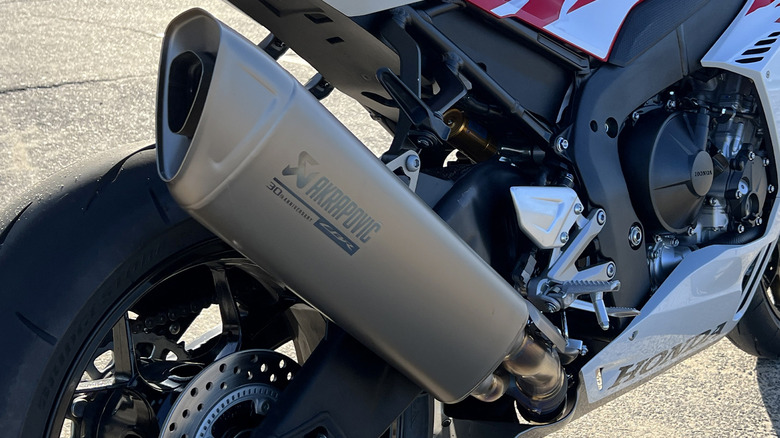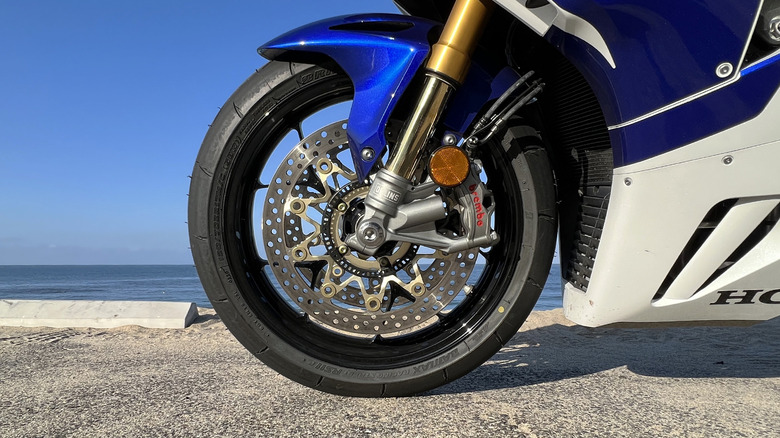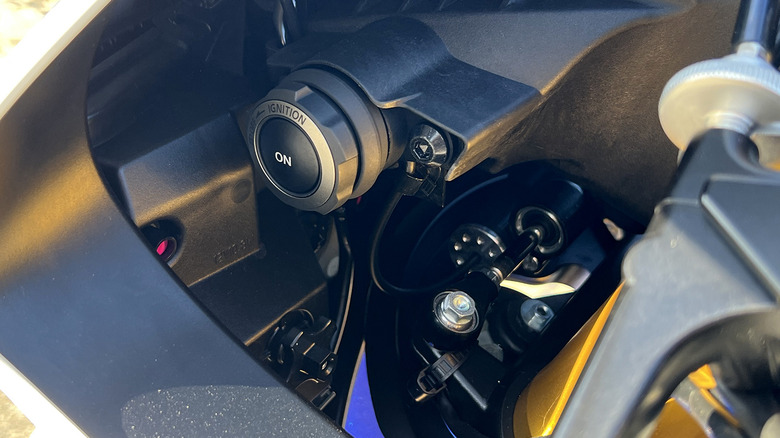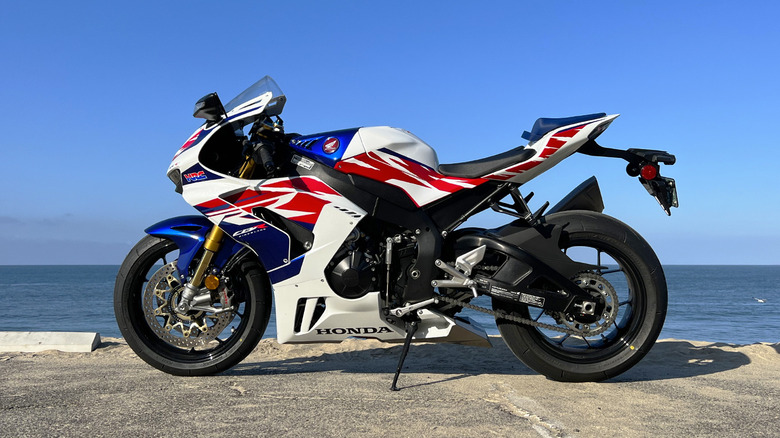Honda CBR1000RR-R Fireblade SP Review: Turns Every Road Into A Track
- Spectacular superbike for the street
- Screaming inline-four engine
- Perfect components and excellent electronics
- Probably too small for taller riders
- On the heavier side of superbikes
- Hard to fully engage outside a track environment
The first time I fire up a CBR1000RR-R at Honda's headquarters in Torrance, California, the engine sounds surprisingly tame. Just quietly purring along for the first few moments, at barely more than a buzz, even after I try a pop of throttle to spool up the inline-four. Then I pick my left foot up onto the peg—or try to, I can barely fit the rear set to make sure I've got first gear selected. Feathering the clutch, I inch forward while picking up my right foot, still feeling awkward as I ease into the twist a bit more and discover torque for days even right on the edge of stalling from a stop. Time to ride home.
I quickly discover that the 999cc straight-four wakes up at about 6,000 RPM, Akrapovic titanium exhaust all of a sudden newly echoic and booming all the way up near the 14,000-RPM redline. But I won't get anywhere near there on my first ride, since first gear is tall enough to reach at least 95 miles an hour. The little bike scoots up to highway speeds (and beyond) and I start having some fun, hair fully on fire, so I can't exactly look down in that moment to confirm the precise top speed at redline.
Akrapovic screaming and wind picking up, perched on a high seat bent over low handlebars, windscreen barely cutting down any of the wind blattering my helmet: for the first time, I truly understand the idea of a crotch rocket. This is the CBR1000RR-R Fireblade SP, a name so long fans typically just say "Fireblade" or "Triple-R" (even if there are five Rs in the full name). As both the name and lightning-inspired livery suggest, the Fireblade is the craziest creation currently in Honda's motorcycle lineup.
Trying to fit on the latest Fireblade
That Fireblade moniker traces back to the early-1990s, when Honda first crammed an 893-cc inline-four into a bike with the dimensions of a 600-class. Later, the Fireblade doubled down on the RC51 recipe that took the fight to Ducati with a world-beating superbike, promising both incredible performance and impressive reliability—or, more accurately, doubled the cylinder count with that quintessential four-cylinder engine. Only the RC213V-S, a true MotoGP bike homologated for street use, delivers more Honda racing tech in one package, a package which ran well into six figures when new and commands even more money at auction today. In contrast, the current 30th anniversary Fireblade celebrating three decades of superbike stardom stickers at a healthy sum of just $28,900 to start.
Here in the US, the Fireblade's dual-overhead-cam mill earns a rating of 188 horsepower and dyno tests usually show somewhere around 75 lb-ft of wheel-torque. Those figures drop in a big way from the rest of world's output of 213 hp and 83 lb-ft due to sound regulations, which required a small revision to the intake air box. But electronically adjustable Öhlins dampers, customizable ride modes, and all the computerized nannies expected all come standard.
A delayed anniversary for the U.S.A.
My loaner wears unique-for-2022 30th anniversary livery and etching that proudly declares Serial No. 377, though Honda never truly limited production. Other model year updates run the gamut from new intake ports to a new throttle return spring, quick-shifter mechanicals, and front brake materials. The model year 2023 is the exact same bike, Honda confirmed today, celebrating the original CBR900RR's 30th U.S. anniversary (riders here had to wait until 1993 for sales to start, an extra year past their European counterparts). In the meantime, three model year 2022 Fireblades still sit in dealer inventory for buyers ready to climb aboard and hang on for dear life.
Hanging on for dear life becomes the name of the game very time I climb on the Fireblade, as I rediscover strange ergonomics that mesh uncomfortably with my 6'1" long-limbed frame. The bike itself rides low and lean, though a lot of heft crams into a tiny package so the impression of 445 pounds somehow seems heavier than perhaps a scale might read out. The low bars cant down and out, the pegs riding crazy high up near the sharply tilted seat. I cannot stop thinking that I'm splayed out like a frog on a log, even if the posture gets me right in the mood to rip.
How to dial in the perfect ride modes
With so much peak power, the Fireblade also delivers enough low-end grunt to tool around town at 3-5,000 RPM with the exhaust humming and neighbors happy. I end up starting in second gear from most California stop signs and even stoplights, before the smooth and refined powerplant winds up to reveal the Mr. Hyde that such a refined Dr. Jeckyll persona only hints at occasionally in the lower revs. After a tall first gear, tight ratios make snapping through all six gears—either up or down—an absolute joy. Rev-matching never felt so easy, thanks to impeccable clutch action and the perky little inline-four.
But as smooth as the Fireblade can glide around town, I still recommend setting up the three customizable ride modes in advance. The process gets very annoying while on the move, fiddling with little buttons on the low left grip while trying to keep an eye on tiny font on the gauge display tucked deep beneath the minimal windscreen. I actually needed to pull out the owner's manual to figure out what each setting and number means, since high and low digits don't necessarily make a lot of sense—turns out the lowest number means most aggressive.
How to dial in the Fireblade's perfect settings
Eventually, I landed on a full Track-ready selection of settings for Mode 1, something closer to Sport with nannies turned a little way up in Mode 2, and a pretty restrained setting with softest suspension and least sensitive throttle for Mode 3. Throttle response makes a big difference, especially in town, but not as much as the Öhlins dampers. Ask any cycling nerd about solid front fork design in the carbon-fiber era and they should know that a point exists where firm suspension actually allows the road surface itself to dampen out bumps and buzzes more than the suspension components.
With the Fireblade's Öhlins set to softest (3), that phenomenon occurs here—the 405 freeway is still pretty rough but speedbumps and cracks in the road are surprisingly not too bad. Stepping up to the two firmer suspension settings goes into the realm of seriously taut and stupendously communicative. Do you want to know about every single grain of dust on the road, or do you want to feel every single grain of dust on the road?
But as an advantage, firming up the Öhlins also prevents quite as much nosedive while braking hard, given the seemingly endless bite of Brembo Stylema calipers on dual 330-millimeter rotors up front. Unlike the cable-operated clutch lever, which delivers that impeccable shift action, Honda decided to keep the rear brake 220-mm rear disc's caliper hydraulically controlled for better modulation. That clutch, though, reveals the mission of simplification where necessary to keep the Fireblade a screaming good deal. No carbon wheels and no rattling dry clutch here, to say the least.
Splayed out like a frog on a missile
Putting the engine into P-1 and P-2 can easily cause lurching higher up in the screaming rev range, so I preferred P set to 3 at almost all times, unsure whether I'm actually cutting back on total power or merely adjusted the drive-by-wire system's sensitivity. Regardless, screaming definitely fits into the fun once fully unleashed in the canyons of Malibu and during my first motorcycle ride up on the Angeles Crest Highway.
On the Fireblade, I once again learn the importance of vision, in this case somewhere near a hawk's tunnel vision for details farther down the road than any vehicle I've ever driven, ridden, or piloted. Looking far, far ahead to set the tires on the right path, I shift my body weight on and around the bike to brace while countersteering, centripetal forces compressing me noticeably into the pegs and bars. More of a frog on a missile, maybe.
Nowhere near the Fireblade's limits
Staying anywhere near sane on public roads means that engine braking can do most of the job hauling down speed at the end of long sweepers, especially when taking advantage of the tight gear ratios while downshifting. Gripping the brake lever hard into tighter corners causes minimal upset to balance unless on a steep descent, though, and the bike just oozes composure despite my inability to come anywhere near the promised limits of performance.
The physical fit contributes to my inexperience harnessing such a weapon, as I slide forward and back on the seat constantly, struggling in vain to find some semblance of grip on the tank with my inner thighs but eventually just accepting that my feet on the pegs and hands on the bars need to bear the brunt of the work. Maybe my leathers need some marring—or some skateboard grip tape, more likely—since I slam into the pillion pad repeatedly while accelerating. But even while stopping slowly or sitting still, I frequently slide forward on the seat and slam the family jewels into the fuel tank, too.
Pro tip: always use protection
Full leathers feel absolutely required at all times on the Fireblade, even while playing Tetris in my garage. Only one other bike with comparable levels of insanity that any manufacturer has felt comfortable enough loaning to me arrived last year, and yet I keep feeling flashbacks to that Ducati Streetfighter V4 SP. But the Streetfighter's upright riding position, which makes the bike so much more comfortable as a daily rider, also belies the incredible performance potential baked in. Somehow, the Fireblades lower bars and seat—not to mention peg position—makes less power and more weight somehow seem gnarlier.
An entirely different ballgame, in fact. Countersteering into the first open turns in Topanga, I never even leaned out too far because the lowslung aluminum frame allows the Fireblade to corner in a tighter radius than I ever imagined. I keep an eye on the gauges, looking down through the windscreen, as my line cuts in so far before apex that I even thwack my visor on some chaparral. And yet, I notice after my first couple outings on brand-new tires that I've cut less into the tread than on the Streetfighter V2 I recently blasted around Monterey for six days. Time to trust the bike more, I figure.
But the truth remains that the Fireblade belongs out on a track. Even the softest settings leave me sore and aching after an hour or two of riding. By the end of my longest day, over six hours in two stints, I regularly miss shifts and struggle to even twist the throttle at all because my wrists simply will not respond. For a road cyclist used to the most aggressive geometry possible on carbon-fiber bikes, I know that keeping weight on my feet and using my core more helps. And yet, I can't find a happy middle ground while riding straight—the only comfortable thing to do is corner hard while leaning out off the saddle.
Pros and cons definitely tipping towards the former
I mention my Fireblade fit woes to a friend and he lets me climb aboard his brand-new Ducati Panigale V4R, undoubtedly the most hardcore sportbike on the market today. I fit much better, without a doubt, and the urge grows to compare the Fireblade to something similar. But the V4R's price tag approaching $50,000 makes Honda's range-topper seem almost reasonable at just over half that starting sticker.
And here's the thing, I realize: The Fireblade is so incredible that, even though I don't fit, I keep finding reasons to go out for another ride. All the touchpoints imbue each single action with absolute precision, the perfect clutch standing out to the point that I rarely use the quickshifter, which works much better with this silky inline-four than a V4. Even the ease of finding neutral, every single time, helps to make each ride feel just right.
The inline-four reminds me of a silky-smooth CB750K I test rode about a year ago, tractable with just enough torque in every scenario but also, therefore, even more rewarding on the way up toward redline, almost akin to a turbocharged race engine that starts raring to run once revved up—though of course, this modern bike by then reaches a level of cacophony that pierces through the frame, seat, bars, my helmet, and finally reverberates into my brain. Given the Fireblade's positioning versus other V4-powered sport bikes from Ducati and Aprilia, rumors that Honda plans to build a V4 superbike seem fairly credible, just for the low-end output, compact packaging, and weight savings a V layout makes possible.
Begging for hard rides daily
The Aprilia RS660, as an example, fit me absolutely perfectly. Despite delivering far less mind-blowing raucous than this Honda, "only" 100 horsepower just about perfectly nails the power-to-weight ratio for me, personally. Maybe I need to try out the RSV4. Scratch that, I definitely need to try out the RSV4—Aprilia's well-known parts and service problems notwithstanding.
A few other gripes do emerge after more time on the Fireblade, though. Constant confusion about the RFID key that works with an electric ignition button and knob never relent, tucked away where gloved hands can barely reach them below and ahead of the gauge display's lower left corner. Is it on, is it off? Who knows, and the "No Key Detected" warning blinks pretty regularly, too. Plus, I need to dig out the physical key any time I stop for gas. And speaking of, the gauge screen supposedly includes a fuel level readout, but I never found it.
Honda Honda CBR1000RR-R Fireblade SP Verdict
Instead, just a warning light to indicate when the 4.3-gallon tank gets low and a mileage readout that starts counting down remaining range—at least a more consistent system than on the Ducatis, which points to the Honda reliability that should come into play here, too, alongside the collectability and general popularity of this bike. Yes, people want to walk over for a chat at gas stations and parking lots, if that factors into the conversation for any potential buyers.
With more time to fiddle through electronics and settings, I believe I could dial the Fireblade in to reach another level of potency for my specific kind of riding. My own Fireblade, meanwhile, would get a different upholstery material on a taller pad to add as much traction as possible to the 32.7-inch seat height (which feels a lot lower, compared to the V4R's 0.8-inch higher seat). Honda also sells a higher windscreen, which sounds nice given that I spent most of 35 highway minutes commuting out to the mountains with my elbows literally resting on my knees like crow pose in yoga. Maybe some aftermarket rear sets to move the pegs a little further forward and down, if possible given the exhaust routing. And tank grips, for sure. Then, maybe one day as my skills and confidence grow, I might come anywhere even close to finding the full capabilities of Honda's latest and greatest Fireblade.
